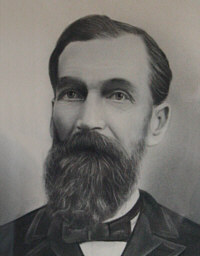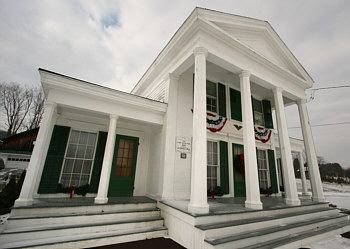At a time when this nation was deeply divided over the issue of slavery, Cyrus Gates made no secret of his strong abolitionist views. Living in the Town of Maine, his farmstead was situated in line with one of many routes taken by runaway slaves seeking freedom. Gates and his wife Arabella opened their home as a safe haven, and together they were to host a station on the Underground Railroad.
Since 1994, the historic Cyrus Gates Farmstead on Old Nanticoke Road has been home to Stephen Beukema and his family. The farmstead consists of thirty acres, several out buildings, a family cemetery, and a magnificent Greek Revival style farm house. A teacher at Whitney Point High School, each day Beukema teaches History, and returns to a home immersed in it.
Born in 1802, Cyrus Gates was to become a cartographer and surveyor. "He mapped eleven counties for the state of New York" commented Beukema. "Cyrus also served for several years as the local Justice of the Peace in the newly formed Town of Maine."
 Construction of the house began in 1848. Gates "hired a man from New York City to build the Greek-inspired farmhouse," said Beukema. "The style would be considered extravagant and over-done for a farmhouse. In fact, the locals feeling somewhat miffed by the use of an out of town builder, called the new house 'Gates' white elephant'."
Construction of the house began in 1848. Gates "hired a man from New York City to build the Greek-inspired farmhouse," said Beukema. "The style would be considered extravagant and over-done for a farmhouse. In fact, the locals feeling somewhat miffed by the use of an out of town builder, called the new house 'Gates' white elephant'."
Four tall columns line the front section of the house and symmetrical columned wings extend from each side. Entering the house one is greeted by the warmth and inviting scent of a wood-burning stove. Magnificent woodwork and period furniture are found throughout the house, and of special interest are the hand-grained wood doors, appearing today just as they did when first built. It is easy to see why, in 1999, the Gates Farmstead was added to the National Register of Historic Places.
Gates' Farmstead certainly qualifies as a "Treasure of the Tier," not only because of its architectural prominence, or its status on the National Register, but more importantly because of the role it played in our country's history.
It is difficult to imagine the cruelty and injustice that was prevalent in some areas of our country in the mid-nineteenth century - today it seems unbelievable that such crimes against humanity could exist in America. Under cover of darkness massive numbers of this nation's people were running for their lives, escaping oppression and enslavement in the South, to somewhat more tolerant conditions in the North, and in many cases, ultimately to find freedom in our neighboring country, Canada.
Making it to New York was certainly no guarantee of freedom, for even northern states had their share of sympathizers to the slavery issue. For those fleeing, there was an even more insidious element to fear - bounty hunters. "The Fugitive Slave Act of 1850 gave bounty hunters from the South more rights to chase slaves into the North and forced northern police officers into arresting and returning runaway slaves that they captured" said Beukema. In addition, the Slave Act established harsh penalties for anyone assisting them in their escape.
Broome County Historian Gerald Smith commented that because assisting escaped slaves was illegal, very little was written to document the activity. "Most of what we know has been passed down through generations by oral history." As a result, there are many stories of Underground Railroad activity in this area, but not much of the information can be substantiated. Smith agrees that the Cyrus Gates farmstead is one location that can legitimately claim distinction as a station on the Underground Railroad.
In fact, Beukema suggests that Harriet Tubman, the most famous "conductor" of the Underground Railroad, may likely have followed the route through Maine, New York, on her many trips back to the South, leading former slaves to freedom on her return north. If so, "I like to think she may have stayed at Gates' station," he said.
 How safe the runaways were while at the farmstead is unknown, but Gates had an emergency plan. Beukema quotes Cyrus Gates' great-granddaughter, Louise Gates-Gunsalus as having stated: "To facilitate the harboring and if necessary the hiding of runaway slaves, the Gates built a hiding place inside the south wing of their attic."
How safe the runaways were while at the farmstead is unknown, but Gates had an emergency plan. Beukema quotes Cyrus Gates' great-granddaughter, Louise Gates-Gunsalus as having stated: "To facilitate the harboring and if necessary the hiding of runaway slaves, the Gates built a hiding place inside the south wing of their attic."
Measuring roughly ten by twenty feet, and only four feet high, the secret room was accessed through a small hidden panel located in the back of a closet in an upstairs bedroom. The family's oral history would seem to be accurate. Built long before prohibition, predating the existence of electrical wires and attic insulation, Beukema and County Historian Smith agree that there would be no reason for the trap door other than to provide access to a hiding place.
The secret room and hidden panel are still there today. Whether or not the room ever had to be used for its intended purpose no one knows. But peering into that cramped attic space brings a flood of emotions, and one can't help but relate to those who paused at this station on their long journey to freedom.
CLICK HERE for more information on the Cyrus Gates Farmstead and its role in the Underground Railroad.
An exhibit on the Underground Railroad opens tomorrow, February 8, and continues through March at the City Hall Gallery, 38 Hawley Street, Binghamton. The exhibit is sponsored locally by the Broome County Urban League, the Forging the Freedom Trail Project Foundation, the City of Binghamton, and Broome County.
"Freedom is where I'm going" is an excerpt from a quote by an anonymous traveler of the Underground Railroad. It is sometimes attributed to Harriet Tubman.


 Cyrus Gates' Station on the Underground Railroad
Cyrus Gates' Station on the Underground Railroad